How and how to treat cabbage from fleas?
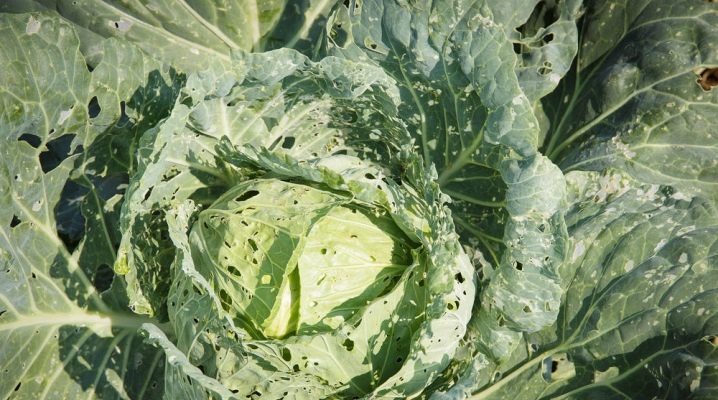
If the young cabbage is covered with a network of holes, then the problem is most likely in the activity of flea beetles. In order not to lose the harvest in a few days, you have to act quickly, not forgetting about preventive measures.
Why are fleas dangerous?
The flea is a small insect, in fact, a leaf beetle, which means that it actively eats seedlings, and, in general, causes irreparable harm to cabbage heads. Creatures measuring no more than 1.5-3 millimeters in length have strong hind legs that allow them to fly up to a height of several meters. Insects reproduce rather quickly and are able to destroy an entire bush in just a couple of days. They become most active on sunny, hot days without precipitation.

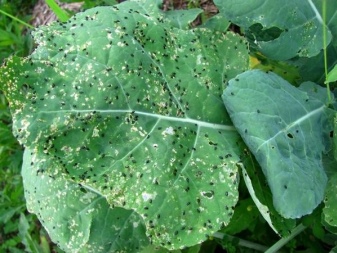
Most often, cabbage seedlings are attacked by flea beetles, although they use young heads of cabbage with equal pleasure. The creatures eat up the plates so that they begin to resemble a sieve due to the multiplying holes. As a result, the plant is generally unable to form a head of cabbage and quickly dies. In principle, the creature is able to practically skeletonize the plates, scraping off the skin.
By the way, it is quite simple to determine that these are fleas. If you slightly stir the cabbage leaf, small shiny bugs will immediately start jumping up and down.
Since insects prefer only delicate leaves, they do the greatest harm to Peking cabbage, whose plates do not become tough almost until harvest. In this case, by cutting a beautiful fork, you can find a whole colony inside. The gluttony of the pest increases during warming, but by the onset of June it slightly decreases. In mid-July, the beetles consume the already strengthened leaves, causing slightly less damage to the garden.

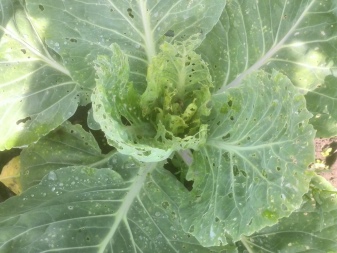
Insect species
Only a few species of fleas are found on cabbage leaves. Light-legged individuals young plants from the cruciferous family are especially appreciated. They have a dark body with a metallic sheen and a yellowish head. The dimensions of the insect do not exceed 4 millimeters. Larvae of light-legged flea beetles prefer leaf blades instead of roots. Small black flea most often found in cabbage beds. It is quite easy to identify it by the monochromatic body color of 2-3 millimeters long.
Quite common and small wavy bugs with a dark body and a characteristic yellow stripe on the wings. Their adults skeletonize leaf blades, and the larvae consume lateral roots. In addition, cabbage, along with other vegetables, often suffers from notched representatives of the species. Unlike wavy, yellow stripes are already found on the body.
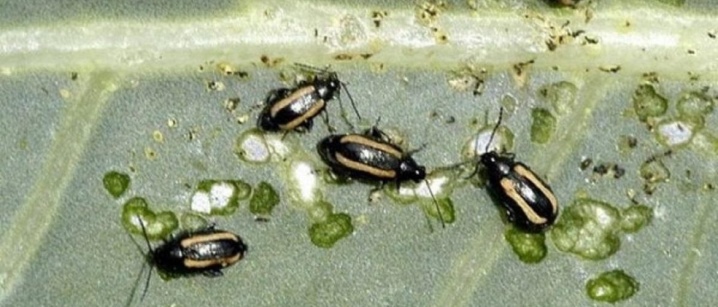
Why do they appear?
Fleas attacking cabbage usually spend the winter in the ground, safely hiding under fallen leaves. With the arrival of warm days, they come to life... In June, females lay their eggs either in the ground or directly on the plants. The larvae that appear after a couple of weeks feed on cabbage roots, and then, having reached maturity, attack the leaves of the heads of cabbage. All this happens for different reasons.
For example, unfavorable conditions may be to blame: high temperatures and dry air, which are optimal for population growth.
Of course, a large number of weeds or thickening in the beds provoke their development. If the remains of the plants were not burned in the previous autumn, you can be sure that the pests hiding in them are already ready to move to cabbage. The reasons for the spread of insects also include:
- lack of deep digging of the soil at the end of the season;
- drying out of the soil;
- late sowing of seeds, which means the weakness of the seedlings.
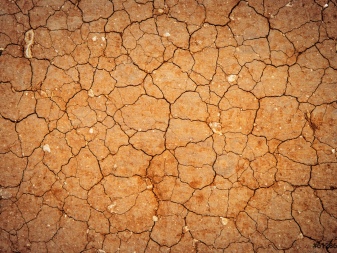
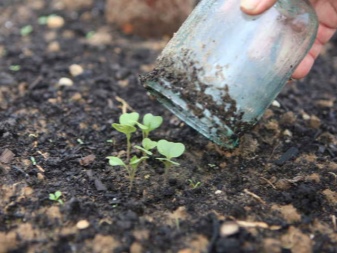
How to fight?
When pests appear on cruciferous plants, it is first of all better to use folk methods, and then, if they do not work, turn to more effective chemicals.
Traditional methods
It is wiser to treat flea beetle cabbage with homemade mixtures in the early stages or shortly before harvesting. Such an environmentally friendly substance will not harm the edible part of the plant, but it will effectively cope with the problem. For example, in the open field, it would be good to organize dusting. This procedure is carried out either early in the morning or late in the evening, and always follows after irrigation.
The mixture itself can be prepared from ash and lime-fluff, taken in equal proportions, or ash powder. Mono-components are also suitable:
- tobacco dust;
- naphthalene;
- Red pepper.
The finished “powder” is placed in a gauze bag, nylon stocking or fine sieve, and then evenly shaken out over the cabbage leaves, dusting both the heads of cabbage and the ground under them.

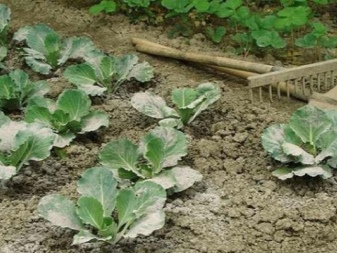
Cruciferous plants can also be sprayed with a variety of homemade preparations. Most of them, as a rule, allow not only to protect the culture from insect attacks, but also to feed it.
- To create the ash solution, the key the component is steamed with boiling water in a ratio of 1: 3. If you add shavings of laundry soap to the mixture, you will be able to improve its fixation on green leaves.
- Sprinkle on the cabbage and garlic tincture, but it's worth doing while the liquid is still warm. At the cooking stage, a glass of garlic cloves, the same number of their leaf blades, as well as tomato stepsons are cut to the smallest fragments. A meat grinder or blender will help to cope with the task. The mass is poured with 10 liters of heated liquid and supplemented with a tablespoon of grated soap.
- Get rid of fleas will allow infusion of 0.5 kilograms of dandelion leaves and roots, 10 liters of liquid and a tablespoon of soap.
- It will be very effective to dilute chicken droppings in a ratio of 1: 20 and let it brew on the street for about two weeks.
- It will definitely be possible to remove insects with the help of vinegar... The key component in such a mixture is 250 milliliters of nine percent table vinegar or a couple of tablespoons of essence, and this component is diluted with the same bucket of water.
- It is considered quite effective to water the beds. tobacco-soap solution... During its cooking, you first need to pour 200 grams of tobacco with 10 liters of freshly boiled water, and then, after waiting for it to cool, strain everything and add soap shavings.
- Wormwood infusion is obtained from 100 grams of grass and a bucket of water.
- For potato broth you need 4 kilograms of potatoes and 10 liters of boiling water. It is recommended to dilute the broth after straining before irrigation with another 10 liters of water.
- Tomato-based broth prepared from 2 kilograms of dry tops or 4 kilograms of fresh, as well as a bucket of cold water. First, the mixture is infused for about 4 hours, and then boiled over low heat for about half an hour. After cooling and straining, the broth is combined with clean water in a 1 to 1 ratio and supplemented with 40 grams of liquid soap.
- To combat the flea, gardeners also prepare a mixture of 20 milliliters of ammonia and 10 liters of water. The presence of ammonia in the composition provides an additional build-up of the green mass of the plant.
- Some gardeners prefer to fight the "conquerors" with homemade sticky traps. The base, which is a piece of thick fabric, cardboard or a piece of thin plywood, is fixed on a stick and coated with resin or a similar adhesive substance. The structure will need to be installed in the garden.
- Saving your crops is also worth trying. using a rag soaked in used diesel or car oil... The blanks are laid out on cardboard boxes placed near the beds. After a couple of days, they turn over.
- Whiteness helps to drive the pest from the beds. Pieces of old fabric with sides equal to 30 centimeters are soaked in the drug solution. Further, they are distributed over the beds in such a way that at least one specimen is found on each square meter. Every evening, the rags should be moistened with a new portion of sodium hypochlorite.
- Another effective recipe is to use birch tar... A teaspoon of the drug is diluted in a liter of water with a small amount of liquid soap.
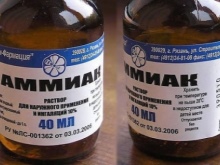
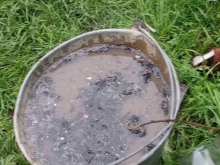
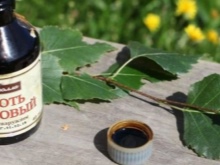
Chemicals
If the culture is in conditions of severe damage, then it will be possible to destroy the pest only with the help of a strong poison. Chemistry should be used long before harvesting heads of cabbage.
- You can poison a flea with a universal Bi-58diluted in 5-10 liters of water.
- If the pest attacked at a time when the temperature on the street was set equal to 24-35 degrees Celsius, then it is better to use "Decis". The toxic drug immediately kills the pest and is not removed from the sheets for the next 20 days.
- "Imidalite" more suitable for disinfection of seed, and "Diazion" - for treatment of beds, carried out before transferring seedlings to open ground.
- Fast results can be achieved "Bankol", causing paralysis of the nervous system of a harmful creature after 3 days. In this case, only 7 grams of the substance have to be used per bucket of water.
- Convenient to use medium toxic "Aktaroy" contact-intestinal action, which does not require additional dilution and rapidly decomposes in the soil.
- Good and Actellik. The solution obtained by combining 2 milliliters of the drug and 2 liters of water gets inside the leaf blades, and insects, consuming them for food, quickly die.
- "Initiative" it is allowed to use it for seedlings, as well as immediately after its transfer to open ground.
- From biological products for culture are suitable Fitoverm, causing paralysis of the creature 10 hours after treatment, as well as "Aktofit". The latter in the amount of 4 milliliters is diluted with 10 liters of water and immediately used for spraying. The treatment should be carried out on a warm day, when the temperature is in the range from +16 to +28 degrees, since the effectiveness of the insecticide decreases in cold weather. After only 12-18 hours after spraying, the bugs will stop moving, and after 2-3 days they will completely die.
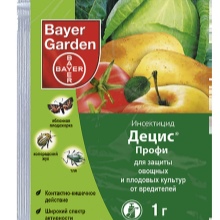

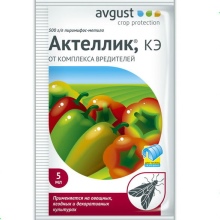
In general, when working with all chemicals, one should remember that they should always be diluted according to the instructions, and all processes should be dealt with, protecting the eyes, skin and respiratory organs. Spraying is carried out on a dry and calm day, ideally in the evening, when the activity of flea beetles decreases.
Preventive measures
Timely prevention is one of the most effective methods of protecting cabbage from flea beetles. So, after the seedlings are in the open field, they will need to be covered with a special non-woven fabric - for example, a spandbond. Thanks to this, while the seedlings are getting stronger, they will not suffer from pests, and then, when the foliage has already acquired the required rigidity, the material can be removed. River sand, which forms a 1 centimeter thick layer, can become an alternative to the protective canvas.
Planting next to a coriander, garlic or dill crop will give good results. All these plants have a strong odor, unpleasant for flea beetles, and therefore form a kind of protective wall. Late varieties of cabbage are best protected by placing nasturtium, marigolds and calendula on adjacent beds.

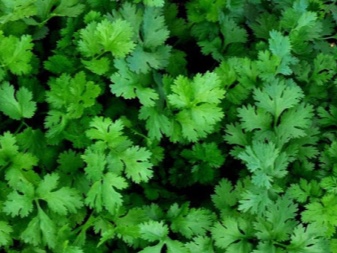
Preventive measures include daily unfolding of freshly plucked wormwood between rows. Water intended for irrigation can be supplemented with pine and fir oils, as well as corvalol and valerian tincture. An additional component in the amount of 10-15 drops is used in a bucket of settled water. Certain agronomic rules are also important to protect crucifers. It is important to regularly free the plantings from weeds, and after harvesting, it is imperative to dig the soil - so insects hidden in the ground will appear on the surface and die from the cold.
Thoughtful prevention also includes maintaining crop rotation, dressing the seed, frequent irrigation and regular fertilization.
By the way, watering really plays a significant role, because leaf beetles feel especially good in hot and dry weather.
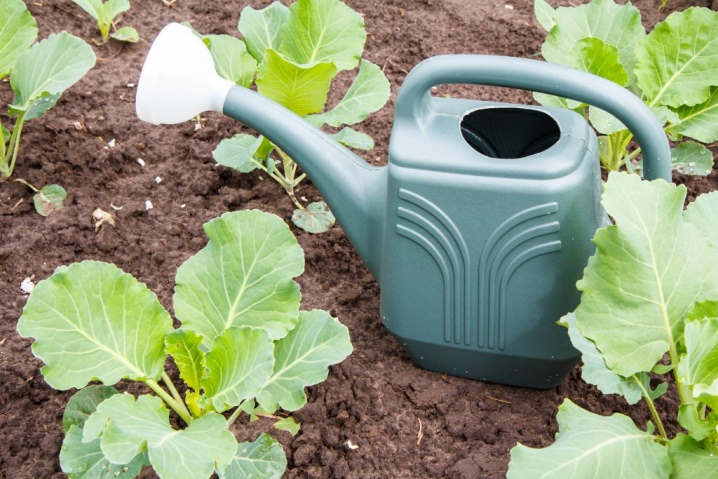













The comment was sent successfully.